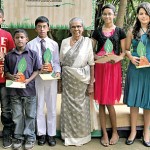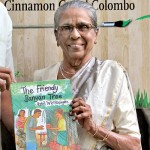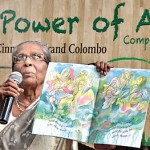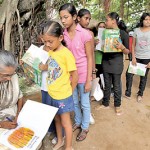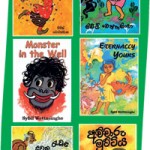Sybil Wettasinghe A tribute to Sybil Nenda
 Sybil Nenda – or ‘Aunty Sybil’ as we lovingly know her, passed away on July 1, but she has left us a treasure trove of books.
Sybil Nenda – or ‘Aunty Sybil’ as we lovingly know her, passed away on July 1, but she has left us a treasure trove of books.
Sybil Wettasinghe was born in the beautiful village of Gintota in Galle on October 31, 1927, 92 years ago. It was the village and its serene beauty that made her first draw – and she drew naturally – it was how she expressed herself. If she was sad, she put it on paper with an easy flowing line; if she was hungry she would draw to let her mother know.
She called her village upbringing “a long, beautiful dream. Then people seemed to live as warm-hearted human beings, giving out love and affection, caring for one another with a kindred togetherness.”
When her family moved to Colombo, she was six, and Sybil entered
Holy Family Convent, Bambalapitiya. Her grandfather was a sculptor and her mother was an artist with lace-making.
Sybil was the apple of her father’s eye and it was to him she ran when friends teased her for being dark, calling her ‘Kalu’.
When only 17, Sybil would join the Lankadeepa newspaper as an illustrator. In 1952, she was recruited by Lakehouse Publications. As main illustrator of the Janatha newspaper she was the first Sri Lankan woman to work full-time as a journalist. She would later draw for Sunday Observer, Silumina, Daily News and Sarasaviya.
Also in 1952, Sybil dreamed up her famous ‘Kuda Hora’ (The Umbrella Thief) for the children’s page. It was the story of a certain mischievous ‘person’ who stole umbrellas from a whole group of villagers that became her first book, triggering more than 200 other beautiful volumes.
Among the most famous are
‘Little Granny’, ‘Monster in the Well’ and ‘Magul Gedara Bath Natho’. In 1995, she won the Gratiaen prize for ‘Child in Me’, which was a book that looked back at her blissful childhood, from where she drew so much happiness and from where come the ideas for all her books.
But the awards she won are so numerous. In 1965, her story ‘Vesak Lantern’ won an Isabel Hutton Prize for Asian Women writers for Children. Her first book ‘Kuda Hora’ was chosen for the Best Foreign Book Award in Japan in 1986. ‘Kuda Hora’ alone was translated into English, Norwegian, Danish, Japanese, Chinese, Korean and Swedish.
Last year she produced ‘Wonder Crystal’, which has a Guinness World Record for ‘the most alternative endings for a book’ with 1250 endings by children of Sri Lanka. The endings were of (prose) writings, drawings and poetry.
The beautiful, lively trademark art of Sybil Wettasinghe was enjoyed by many generations of children across the world. They will stay with us for long years to come, as they have for nearly seven decades. - Pix: Funday Times file photos
- With Power of Art competition winners
- At the launch of ‘The Friendly Banyan Tree’ with Funday Times members at Nuga Gama, Cinnamon Grand



